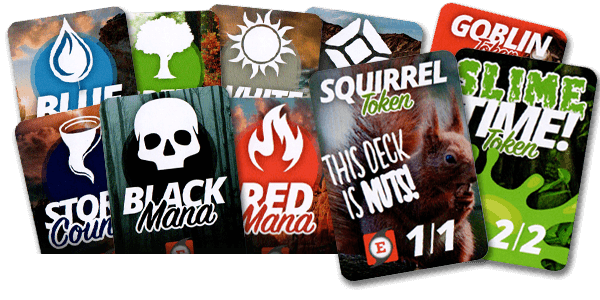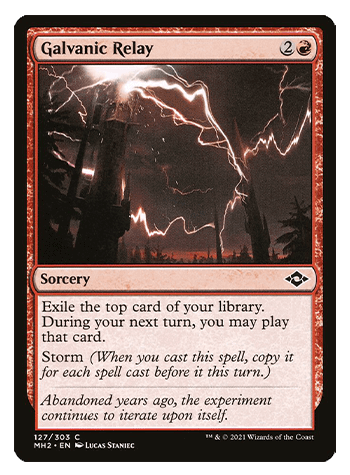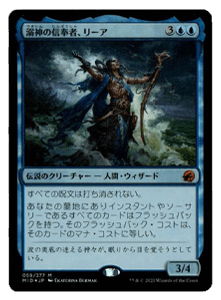Deck Lists & Explanations
When you look at 2019 and The EPIC Storm, the list v7.5 defined the year. When you look at the numbers behind it (view historical data spreadsheet), it was remarkable for its time. Not only did it have it the most matches played in my tracking history, but its numbers overall were better than anything else I tested during that time — with a match win percentage (MWP) of 63.28 percent when most other lists were about 60 percent. The big innovation behind v7.5 were the main deck copies of Defense Grid to support the three copies of Mox Opal. Shortly after the innovation behind this list, I won a Legacy Challenge and thought to myself, “maybe this has more potential than I thought?”
Then Modern Horizons happened… which brought in Plague Engineer and Wrenn and Six. Plague Engineer was an obvious problem for the deck trying to generate Goblin Tokens, but Wrenn and Six was an issue for other reasons. RUG Delver came to rise in popularity, which could pressure our life-total essentially shutting off both Ad Nauseam and Empty the Warrens, making the matchup tougher than most of us wanted to admit. While we never sideboarded in Hope of Ghirapur against the RUG Delver decks of the format, sometimes we did against certain variants of 4-Color Control. Due to Wrenn and Six, Hope of Ghirapur was unplayable in that matchup. After 482 matches with v7.5, it was time to hang it up as one of our better matchups, (Miracles), was essentially removed from the format.
For months, I tried various lists trying to solve the Wrenn and Six metagame, but ultimately sort of lost interest in Legacy and decided to code a brand new theepicstorm.com for everyone to enjoy. That’s when Wrenn and Six was banned, and all of a sudden my favorite metal bug, Hope of Ghirapur, became playable once again. This is how we ended up on v8.3. It’s not terribly different from v7.5 by any means as it has just one less Mox Opal and one less Defense Grid for two copies of Duress in the main deck with a slightly different sideboard. With more combo in the metagame, it made a lot of sense to want more disruption.
The night before Thanksgiving, I was playing a few leagues on Magic Online when I felt sort of defeated by Veil of Summer out of the blue decks to protect their copies of Force of Will. It hit me that night that I wanted to move into the future of The EPIC Storm. I’ve known for some time the future of the deck was tied to Mox Opal in one way or another, and I wanted to play a list with four copies. I had the deck list open, and as I began to drag around cards, I realized there just wasn’t enough room for everything. I ended up with no copies of Rite of Flame at one point, too many “tutor effects” when I tried to add in Wishclaw Talisman, and four main deck Defense Grid in a delirious haze trying to find enough artifacts to support Mox Opal. Staring at a list that contained 64 cards, that’s when it clicked — “I need to cut Infernal Tutor.” Infernal Tutor has been such a sacred cow up until this point where I’ve never really given not playing it a real consideration.
Now the ball was moving and I started to see things a little more clearly. Empty the Warrens plays really poorly Wishclaw Talisman as your opponents can just search up their answer to a horde of Goblin Tokens, which meant that it was a likely cut. I was now looking at Wishclaw Talisman and trying to examine to more effectively use this card. Because it can get anything, it often means that you’re getting the best card in your deck — Lion’s Eye Diamond. If you’re often getting Lion’s Eye Diamond, you should probably be playing more than one copy of Echo of Eons in your 75 cards because chances are you may need multiple in a game. One of the issues with Infernal Tutor was that due to its Hellbent restriction, you often needed to use Lion’s Eye Diamond to empty your hand meaning that you’re now paying six mana for a Timetwister. In comparison, if you already have access to a copy of Lion’s Eye Diamond, you’re now able to just search up the lone copy of Echo of Eons out of your deck with Wishclaw Talisman easily. This made the main deck copy of Echo of Eons a slam dunk, especially in the deck dropping a bunch of zero-mana artifacts on the table on the first turn. Echo of Eons provides an easy way of refilling your hand and getting ahead of the opponent on the battlefield. Often times, it’s essentially starting the game with 3-4 mana and a copy of Defense Grid compared to your opponent’s single land. Because you wanted to be playing out permanent mana sources and re-stocking with this list, I tried very hard to find room for all eight “Mox effects.” This meant going down to 12 lands, which is fine, especially when your game-plans involve drawing a ton of cards. Eventually, this list became v8.4.
At this point, I shared the list with the team behind The EPIC Storm. I’m only one person, and all of my ideas aren’t great (despite what I may or may not think)! The team really helped refine the list at this point with several of us trying out different things such as no copies of Rite of Flame, Simian Spirit Guide, main deck Tendrils of Agony, main deck copies of Chain of Vapor, and other things. The biggest take away was moving from Thoughtseize to our own copies of Veil of Summer. If our opponents are all going to be playing Veil of Summer, why are we bothering with discard? Let’s just make their own copies “dead” cards. At this point we’ve arrived at four main deck copies of Veil of Summer and two Defense Grids with a draw seven in our deck.It’s very reminiscent of the very early days of The EPIC Storm with Orim’s Chant and Diminishing Returns (if you’re interested in more of this, check out our history page)! The big difference between the past and today is once again Mox Opal. What Mox Opal provides is a consistent way of producing all four colors without needing to sacrifice our mana-base entirely to play cards such as Gemstone Mine. It’s likely one of the more powerful cards in this list for that reason. Going back to Veil of Summer and Echo of Eons, unlike Thoughtseize, Veil of Summer protects your freshly drawn cards from being interacted with by the opponent which is a huge upgrade. If you’re interested in more about v8.5, I highly recommend checking out Alex McKinley’s latest article.
At this point I’ve talked a lot about deck building for an article that’s supposed to be about data. Let’s look at the numbers that helped me influence some of these decisions that were made and some interesting findings about these four deck lists.
Data Percentages as of 12/10/2019
| Deck Version | Match Win % | Play Win % | Draw Win % | Mulligan % | Combo Turn |
|---|---|---|---|---|---|
| v7.5 | 63.28% | 62.82% | 58.45% | 22.40% | 2.45 |
| v8.3 | 66.10% | 70.18% | 59.30% | 21% | 2.60 |
| v8.4 | 66.67% | 64.52% | 56.47% | 25.9% | 2.68 |
| v8.5 | 73.26% | 69.66% | 62.02% | 20.6% | 2.79 |
Play / Draw
I’ve received a few messages recently about the difference of being on the play versus being on the draw for the win percentage. We thought that due to Veil of Summer and turn one Wishclaw Talisman, the on the play win percentage would be higher than normal. When you look at the historical data of these numbers, they tend to align with the all of the post-Deathrite Shaman percentages.
Mulligan Percentages
When you look at v7.5, v8.3, and v8.5, you can see that the mulligan percentages are close enough to where they’re not surprising. Meanwhile, v8.4 the numbers jumped up. This can be explained by the drop down to 12 lands with an extra copy of Chrome Mox. An increased percentage in mulligans doesn’t need to be a bad thing, especially in a deck that contains an Echo of Eons to get you back into the game.
Average Combo Turn
The numbers here make perfect sense to me. When you start at v7.5, it has an additional copy of Mox Opal and less protection, meaning you’re less inclined to wait to go off. A note of importance is that Modern Horizons was released in the middle of the data set, and at some point, we had to start playing around Force of Negation. Now in comparing v7.5 to v8.3, we have additional disruption and less speed and seeing a slight decrease in the average combo turn should be expected.
When we switch over to the Wishclaw Talisman lists, the average combo turn also adjusts upward. The reasons are pretty obvious. Ad Nauseam lines cost one more with Wishclaw Talisman (although, you can still Echo of Eons for five or six mana), and there’s additional mana constraints with more colors for Veil of Summer.
Archetype Win Percentages
| Deck Version | vs. Blue Decks | vs. Non-Blue Decks | vs. Prison Decks | vs. Combo Decks |
|---|---|---|---|---|
| v7.5 | 56% | 84% | 61% | 61% |
| v8.3 | 68% | 71% | 43% | 81% |
| v8.4 | 56% | 67% | 78% | 81% |
| v8.5 | 78% | 60% | 64% | 77% |
These numbers are super fascinating to me. When looking at the deck versions versus blue decks, the two versions that stand out are v8.3 and v8.5. That is because v8.3 is playing an additional piece of disruption in the main deck and then a Duress in the sideboard. Meanwhile, v8.5 has all high-impact cards in these matchups between Veil of Summer and Defense Grid with no discard spells. These lists are also the most stable regarding their mana as they both contain 13 lands and one less “Mox effect” than their previous counterpart.
While v8.5 may have increased stability and quite a few match win percentage points against blue decks, it lost a step in speed on the average combo turn. The quarter of a turn in speed really opened the window in a few matchups that are traditionally very favored to give the opponent a better chance of winning. Part of this is losing Thoughtseize, which is good in almost every matchup, and swapping it for a card with less applications. v8.4 had less of an issue against these decks due to having both Thoughtseize and more fast mana. The difference here is it occasionally lost to itself more often due to mulligans as noted above. v8.4 is very fast which helps against opposing combo decks and prison, but is a little too “glass cannon” for my tastes.
An interesting note about v8.5 is it’s win rate against prison decks is higher than “classic TES” lists while being a step slower. I attribute this to the ability to search for answers against these decks and then win the game afterwards. You may be wondering, “why isn’t that the case for non-blue decks?” I don’t have a great answer there yet.
In general, I’ve had a lot of success with The EPIC Storm post-Wrenn and Six ban (Spreadsheet here). You can view the metagame tab for the full break-down by decks, as I write this article I’d like to call attention to a few of the results:


Miracles is by far the most-played deck in the new world and The EPIC Storm is very good against it due to Veil of Summer, Defense Grid, and Hope of Ghirapur. The same could be said for 4-Color Control and Sneak & Show as well (These numbers do not include the UG Omnitell deck).
BUG Delver is a real issue. Between Thoughtseize, Hymn to Tourach, Daze, Force of Will, Force of Negation, Plague Engineer, Abrupt Decay, and more, it makes the matchup very difficult to win and it’s a real check for this new The EPIC Storm list. That said, after the first few weeks of the format, I haven’t actually faced a single BUG Delver opponent since v8.5 (pre-Veil of Summer). I’m not sure how well Delver of Secrets variants are positioned in a world with lots of snow basics and Arcum’s Astrolabe. A lot of larger control decks have been making a comeback and this creates an issue for them.
The last thing I wanted to bring to light was that The EPIC Storm is the decks I’ve faced the most! Usually my data is slightly skewed since I am unable to account for myself in the metagame. The deck is picking up steam as it doesn’t care about opposing copies of Veil of Summer which is pretty cool.
Win Condition Percentages
| Win Condition | Tendrils of Agony | Empty the Warrens | Grapeshot |
|---|---|---|---|
| v7.5 | 61.53% | 32.64% | 2.92% |
| v8.3 | 69.23% | 29.67% | 1.10% |
| v8.4 | 78.41% | 7.95% | 10.23% |
| v8.5 | 69.72% | 8.45% | 17.61% |
The data here is as plain as day. The “Classic TES” lists are more reliant on Empty the Warrens due to it being harder to effectively use Echo of Eons unlike the “Wishclaw TES” lists. After that, you can begin to see the stock in Veil of Summer in the metagame rising as the Grapeshot win percentage increases.
Overall
Using the data we have, we’re able to make adjustments, such as adding the 13th land back into the deck when our mulligan rate increased too much, or knowing the playability of a card (Thoughtseize) in the metagame has gone down, leading to a decrease in win percentage. Using these numbers, my next steps will be to look to improve the non-blue fair matchups (using sideboard space most likely) as they’ve decreased too much.
I’ve been asked a few times recently if The EPIC Storm is going to be what pushes Veil of Summer over the ledge to getting banned. As flattering as that is, I doubt Wizards of the Coast or R&D even knows TES exists. Then again, Adam Prosak did just give us Wishclaw Talisman, so… who knows? In my opinion, I think the color green should be allowed to have anti-blue cards and highly playable cards such as Veil of Summer. What would make these cards more interesting or restrictive is if they were harder to cast. I’m not suggesting making the card cost anything else in terms of mana cost. But right now in Legacy, Arcum’s Astrolabe is allowing individuals to run as many colors as they’d like with next to no drawback. I personally believe we should leave Legacy alone for quite some time and them come back to see if anything is really an issue. If Veil of Summer ends up being an problem, I would suggest making it harder to cast by removing Arcum’s Astrolabe from the format before removing the card itself.
If you’ve made it this far, thanks for reading and keep storming!











